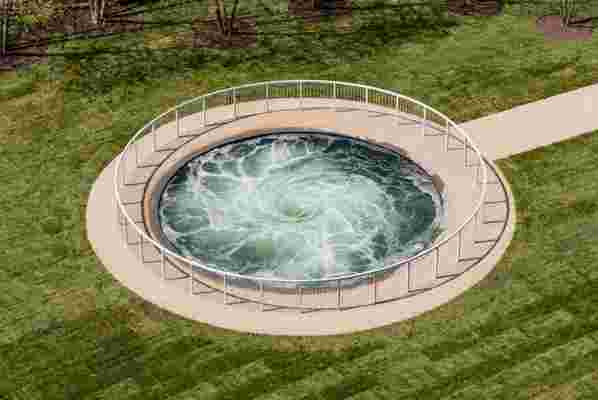On the banks of the East River, and in the shade of the Brooklyn Bridge, artist Anish Kapoor unveiled his latest installation, Descension, a circular pool of constantly spiraling water, embedded into the lawn of Brooklyn Bridge Park.
For Kapoor, whose work is normally meticulously objectified—its form, color, polish carried out with exacting detail—Descension represents something of a departure. It is carefully engineered, yes, but once the artist is done with it, it takes on a life of its own. On a walkthrough with AD , he referenced the installation’s unpredictability, what he called “its own strangeness—it doesn’t behave.” For his part, the artist seems to delight in this misbehavior. “It’s a bit like watching a fire—it’s always changing,” he says.
The project comes to New York thanks to Public Art Fund, an organization that installs contemporary art in public spaces. Kapoor first realized Descension at the Kochi-Muziris biennale, in 2014. There, it occupied the controlled environment of a small, enclosed exhibition space. In Brooklyn, the installation is set en plein air, in the public space of Brooklyn Bridge Park, set against a sweeping vista of the East River and the Brooklyn Bridge. With this different context, the installation avails itself to even more unpredictability.

Of his instillation, Kapoor says, “It’s a bit like watching a fire—it’s always changing.”
The installation is part of Public Art Fund’s 40th anniversary, which will be recognized with a roster of high-profile installations: Kapoor’s Descension and other works by the likes of Ai Wei Wei, Liz Glynn, and Katja Novitskova, and a multi-artist, multi-site presentation, Commercial Break. When it formally opens, on May 3rd, it will also mark the kick-off of NYCx DESIGN, a monthlong platform that showcases different design-related initiatives and programming throughout New York.
Descension, on view through September 10, will continue swirling through all of that. And even without the artist there, the rumbling of its movement will continue to intrigue visitors. “It’s better when the object has its own voice,” says Kapoor. “It gives access to more mystery than the direct delivery of an object.”

Leave a Reply